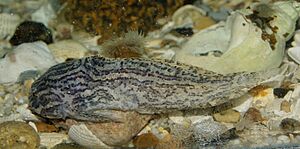Common seasnail facts for kids
Quick facts for kids Common seasnail |
|
|---|---|
 |
|
| Conservation status | |
| Scientific classification | |
| Synonyms | |
|
The common seasnail, also known as the striped seasnail or just seasnail, is a small and interesting fish. Its scientific name is Liparis liparis. This fish is a type of ray-finned fish, which means its fins are supported by bony rays. It belongs to a group of fish called snailfishes. You can find the common seasnail living on the seabed in the northeastern part of the Atlantic Ocean.
Contents
About the Common Seasnail's Name
How Scientists Name Fish
Scientists give every living thing a special two-part name. This helps everyone know exactly which animal or plant they are talking about. The common seasnail's scientific name is Liparis liparis.
Who Named the Seasnail?
The famous scientist Carl Linnaeus first described this fish in 1766. He first called it Cyclopterus liparis. Later, in 1777, another scientist named Giovanni Scopoli created the group, or genus, called Liparis. He put the common seasnail into this new group.
What Does "Liparis" Mean?
The name Liparis liparis is a bit special because both parts are the same. This is called a tautonym. The word liparis comes from an old Greek word that means "sleek-skinned." This name fits the common seasnail perfectly because its skin is very smooth and doesn't have any scales.
What Does the Common Seasnail Look Like?
The common seasnail has a unique appearance. It has a large head and the front part of its body is quite wide. However, the back part of its body is flatter, almost squeezed from the sides. It also has large fins that go all around its body.
- Size: Most common seasnails are about 8 to 14 centimeters (about 3 to 5.5 inches) long.
- Head Features: Its bony head has two sets of nostrils on its snout.
- Special Fins: The fins on its sides, called pectoral fins, are very big. They even join together under its body. Its pelvic fins are also special; they form a large sucking disc right between its pectoral fins. This disc helps the fish stick to rocks or other surfaces on the seabed.
- Dorsal and Anal Fins: The fin on its back (dorsal fin) has many soft rays, usually between 27 and 36. Both the dorsal fin and the fin on its underside (anal fin) overlap its tail fin.
- Skin: As its name hints, its skin is smooth and a bit slimy, and it doesn't have any scales.
Where Do Common Seasnails Live?
The common seasnail lives in the cold waters of the northeastern Atlantic Ocean. You can find it in many places, including:
- The Barents Sea
- Around Novaya Zemlya
- Near Spitsbergen and Bear Island
- As far south as the British Isles
- The Baltic Sea and North Sea
- Around Iceland and Greenland
- As far west as the Gulf of Maine
These fish usually live close to the seabed in coastal waters. They can be found at depths from about 5 meters (16 feet) down to 300 meters (984 feet).
How Do Common Seasnails Live?
What Do They Eat?
The common seasnail is a predator that eats small creatures found on the seabed. Its diet mainly includes:
- Small crustaceans, like shrimps and small crabs
- Amphipods (tiny shrimp-like creatures)
- Polychaete worms (a type of segmented worm)
- Other small fish
How Do They Reproduce?
Common seasnails lay their eggs at different times of the year depending on where they live. In the warmer, southern parts of their habitat, they breed in winter. In the colder, northern areas, they breed in spring.
- Egg Laying: The female seasnail lays her eggs on the seabed. She often places them among short algae or hydroids, which are tiny marine animals that look like plants.
- Hatching: The eggs usually hatch after 6 to 8 weeks.
- Larvae: When the eggs hatch, tiny baby fish called larvae emerge. These larvae are pelagic, meaning they float freely in the water. They become part of the plankton, which are tiny organisms that drift with the ocean currents.


